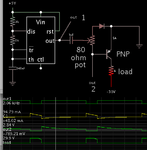eumesh49
Newbie level 3
Hi,
I am trying to build a switch circuit to switch upto -30Volts and to supply utp 5Amp. I need to generate a -30V test pulse for 100usec. So output should be either open or a 100usec, pulse.
I have transient pulse generator, but those generates either -30V or Zero voltage. I dont want that. I want either nothing or -30V. Please suggest if anyone have a idea.
I will highly appreciate it. I tried building using relays, but they are not good enough to have a 100usec pulse.
Thanks in Advance,
Umesh
I am trying to build a switch circuit to switch upto -30Volts and to supply utp 5Amp. I need to generate a -30V test pulse for 100usec. So output should be either open or a 100usec, pulse.
I have transient pulse generator, but those generates either -30V or Zero voltage. I dont want that. I want either nothing or -30V. Please suggest if anyone have a idea.
I will highly appreciate it. I tried building using relays, but they are not good enough to have a 100usec pulse.
Thanks in Advance,
Umesh
